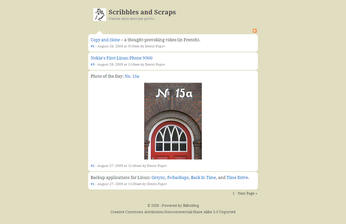Set up a Personal Microblog with Bilboblog

Productivity Sauce
There are many reasons why you would want to run your own private microblog, but how do you actually do that? The easiest way is to install Bilboblog, a tiny, no-frills PHP/MySQL-based microblogging engine.
Although Bilboblog is described as a microblogging application, it's not a drop-in replacement for Twitter or Identi.ca. It's actually more of a hybrid between a microblog and tumblelog. Similar to a conventional microblogging engine, Bilboblog lets you limit post length, but it also supports text formatting and sports the ability to embed images and videos. Bilboblog's major advantage is simplicity: it works right out of the box without any tweaking and there is virtually no learning curve. Better yet, Bilboblog features a one-step installation procedure, so you can set up a personal microblog in a matter of minutes.
To install Bilboblog, create a MySQL database (e.g., bilboblog), grab the latest release of the application, unpack the downloaded archive and move the resulting bilboblog directory to the document root of your server. Make the bilboblog directory writable, and point your browser to http://yourserver/bilboblog. Fill out the required fields, and hit the Install button. Once Bilboblog is installed, you can switch to its administrator interface by navigating to http://yourserver/bilboblog/admin and logging in with the user name and password specified during installation. To create a new post, click on the Add new message link, add text, and format it using the available buttons. If you need help with formatting codes, press the Help button which opens a section containing brief descriptions of the supported formatting options and their usage. Press the Publish button to post the new entry. That's all there is to it. Since Bilboblog is a strictly single-user application, there are no complicated user and access management features, and you won't find any advanced content management features either. Some power users may consider Bilboblog somewhat limited for their needs, but if you want to set up a personal microblog with a minimum of fuss, then Bilboblog might be the right tool for the job.
When using Bilboblog, you'll notice that its English translation is sometimes incomplete and lacks consistency. So I spent an evening going through the language strings and fixing them to the best of my ability. I also did a few minor changes like replacing the default toolbar icons, adding a license to the footer, and slightly modifying the default theme. You can fetch the tweaked version of Bilboblog at my Google Code page. As an experiment, I also host my personal Bilboblog-based microblog on my Bubba Two server. Feel free to drop by.
Comments
comments powered by DisqusSubscribe to our Linux Newsletters
Find Linux and Open Source Jobs
Subscribe to our ADMIN Newsletters
Support Our Work
Linux Magazine content is made possible with support from readers like you. Please consider contributing when you’ve found an article to be beneficial.

News
-
Parrot OS Switches to KDE Plasma Desktop
Yet another distro is making the move to the KDE Plasma desktop.
-
TUXEDO Announces Gemini 17
TUXEDO Computers has released the fourth generation of its Gemini laptop with plenty of updates.
-
Two New Distros Adopt Enlightenment
MX Moksha and AV Linux 25 join ranks with Bodhi Linux and embrace the Enlightenment desktop.
-
Solus Linux 4.8 Removes Python 2
Solus Linux 4.8 has been released with the latest Linux kernel, updated desktops, and a key removal.
-
Zorin OS 18 Hits over a Million Downloads
If you doubt Linux isn't gaining popularity, you only have to look at Zorin OS's download numbers.
-
TUXEDO Computers Scraps Snapdragon X1E-Based Laptop
Due to issues with a Snapdragon CPU, TUXEDO Computers has cancelled its plans to release a laptop based on this elite hardware.
-
Debian Unleashes Debian Libre Live
Debian Libre Live keeps your machine free of proprietary software.
-
Valve Announces Pending Release of Steam Machine
Shout it to the heavens: Steam Machine, powered by Linux, is set to arrive in 2026.
-
Happy Birthday, ADMIN Magazine!
ADMIN is celebrating its 15th anniversary with issue #90.
-
Another Linux Malware Discovered
Russian hackers use Hyper-V to hide malware within Linux virtual machines.


even more steps
breathe
open pc
breathe
connect or check connection [if failing insert an ISO/OSI pile troubleshooting approach]breathebreathe
connect to the server where you intend to set up the software
breathe
breathe I cannot repeat it enough somebody still forget this step
mmm ok the rest is known but remember to add more point for the breathing task.
56465461
More than one installation step!
Tried it, didn't like it.
Re: 1 Step Install?
1 Step Install?
I beg to differ.
Quote:
"To install Bilboblog, create a MySQL database (e.g., bilboblog) (1), grab the latest release of the application (2), unpack the downloaded archive (3) and move the resulting bilboblog directory to the document root of your server (4). Make the bilboblog directory writable (5), and point your browser to http://yourserver/bilboblog (6). Fill out the required fields (7), and hit the Install button (8)."
I must say, that's a mighty long 'step'.